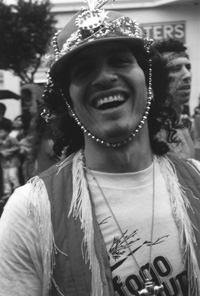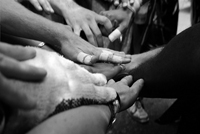The leaves have begun to fall across the San Francisco Bay Area marking the end of Oakland, California’s first “summer of non-violence.” Started in June 2006 by the Ella Baker Center for Human Rights with a series of candlelight vigils held throughout the Bay Area, 1,000 community members prayed for a summer in Oakland without violence and with the presence of constructive change. This violence, which has claimed the lives of one hundred fifty eight men, women and children between January and November of this year, is killing Oakland residents both physically and spiritually.
I attended one of these Vigils on 61st and San Pablo to demonstrate my deep concern. As we discussed our vision of an Oakland without violence, I silently doubted that such an Oakland was possible. But when I thought about the alternative, I realized that significantly decreasing violence is possible, it is necessary, and principled nonviolence could contribute to this change.
In order to clearly understand such a change, I first had to think about the prognosis of what the future might hold if the current situation continues. Remember how you felt the morning of September 12th, 2001? In some parts of Oakland, every day feels like that morbid day. My earliest memories as a child living in East Oakland are of the day after a drive-by in front of my family’s apartment. The fear, confusion, denial, and outrage were hardly different than what most Americans felt the day after 9-11. The difference in my community was that an outside force did not perpetuate the violence; it was perpetuated by and against residents of the same neighborhood. Therefore, we as Oakland residents must recognize the internal nature of this problem and begin to change it from within.
If the violence and fear continue on their course without intervention, Oakland’s violent crime rate will increase, more youth will be sent to suffer in the California prison system, and more people will live lives burdened by the psycho-spiritual aftereffects of violence. In the face of such a prognosis, it becomes alarmingly clear that we have to abandon our old model of living in fear and transform it into courage if we want to rebuild our city.
This transformation of violence into principled nonviolence is deeply connected to an internal transformation within the lives of Oakland’s residents, as illustrated by the life of Stan Tookie Williams, a former resident of San Quentin Prison and a Nobel Peace Prize nominee. Williams co-founded the Crips, a violent youth gang, and after allegedly killing three people, Williams was sent to prison. He continued to live a life encapsulated by violence. Then in 1993, while in solitary confinement, Williams experienced an inner transformation.
Williams told Mother Jones magazine in March/April 2001, “I unchained my mind, and I did so through prayers and extensive study. I had to seriously question whether I was a human or a beast. In choosing not to be a beast, I discovered my humanity. I became autodidactic, self-educated -- a critical thinker.” It was then that Williams began to work for nonviolence. This change included developing a new sense of respect for human life, including his own. It also included taking courageous actions to stop violence and encourage community building, represented by his children’s books about anti-violence where he advocated for youth to courageously reject gang life.
For Williams, this internal transformation was at the core of his work. For Williams to speak about ending violence he had to end it in his heart. As Oakland hyphy artist Ise Lyfe says, “In order to speak about freedom you have to be freedom,” and in order to speak about nonviolence Williams became nonviolent in mind and action. Williams’ experience of positive internal transformation while living in the midst of the most violent of environments, gives hope to Oakland’s residents who seek change.
Like Williams, we daughters and sons of Oakland must transform the violence in our hearts to principled nonviolence. Nonviolence is a rough translation of ahimsa, which means the lack of intention to harm and the respect for all living beings. Different from “anti-violence” – which aims specifically to decrease violence -- principled nonviolence is a way of life and a way of contributing the world. Nonviolence is concerned with the karmic effects of our actions, and it is a means of realizing the integration of humanity. Principled nonviolence is akin to the spiritually grounded “reverence perspective” that activists including Aqueela Shirrill, Julia Butterfly-Hill and Van Jones have adopted in recent years to respectively end gang wars in LA, to protect the environment and to challenge the youth prison system.
There are two facets to principled nonviolence: one is cooperation with good and the second is non-cooperation with evil. When someone spreads rumors about us, steps on our tennis shoes, or hits us, the nonviolent response is to maintain our respect for the other person’s humanity (cooperation with good) while taking action against the harm done (non-cooperation with evil). This takes transforming the heat of rage into disciplined construction rather than letting it explode into uncontrolled destruction.
Living our lives nonviolently and transforming Oakland into a place where residents display deep respect for their own lives and their community not only includes collective internal transformation, it also involves challenging direct and structural violence. Direct violence is exemplified by fistfights or shootings, whereas structural violence is exemplified by poverty or hunger and is the result of exploitive and unjust social, political and economic systems.
Challenging these forms of violence will include an assortment of tactics including fact finding, research, negotiation, education, agitation, legal action, non-cooperation, prayer meetings, meditation, vigils, persuasion, civil disobedience, humor, forgiveness, picket lines, demonstrations, slowdowns, strikes, and boycotts. Although many of these activities have been practiced in Oakland before, I am unaware of them happening as part of a larger, principled nonviolence campaign.
This principled nonviolence campaign would necessitate our participation in constructive programs that function as models for what we do want, while we resist that which we do not want. Many constructive programs already exist in Oakland such as community gardens like SOL (Sustaining Ourselves Locally) and OBUGS (Oakland Butterfly and Urban Gardening), independent media including Indybay.org and KPFA, and educational programs and facilities such as The Freeskool, Upward Bound, Eureka! and The Malonga Casquelord Center for the Arts. These constructive programs contribute to a cultural shift from negativity and violence to positivity and nonviolence. They also provide men, women and children with alternatives to gang life and drug abuse, both of which significantly contribute to violence in Oakland.
By transforming our self-loathing to self-respect, by challenging direct and structural violence, and by contributing to programs that model the peace building that we would like to see, we are planting the seeds for a nonviolent peace movement in Oakland. We cannot wait for the police to change, gangs to dissolve, or for crack to disappear before we start planting these seeds. We must begin to change our own behavior and organize amongst our friends, families, the elderly, parents, children, teachers, students, social workers, laborers, religious and spiritual communities and everyone else who is interested in participating in deep, positive, local change.
What always comes first in a nonviolent movement are people’s decisions to take individual responsibility in making change happen. The action taken once these decisions are made then fuels both inner and social transformation. In this way, nonviolence works like violence: it starts inside of our individual lives and it escalates, affecting our relationships with our communities and with society as a whole. I invite you to join us at any step along the way, in this social, spiritual and psychological experiment with courage, truth, respect, and transformation and see how these forces spiral out from your own life and into the streets of Oakland. May the falling leaves remind you that experimentation with nonviolence in Oakland has already begun.
Jerlina Love is a graduate student in African Diaspora Studies at UC Berkeley, where she studies principled nonviolence.
Silence the Violence, Ella Baker Center:
http://ellabakercenter.org
Jerlina’s Blog on Spirituality, Nonviolence and Art in the Bay Area:
http://i-mlove.blogspot.com
The Metta Center for Nonviolence Education
http://www.mettacenter.org
SGI-USA: A Buddhist network that promotes peace through personal change:
http://www.sgi-usa.org


